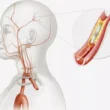Ischemic Stroke Symptoms and Treatment
Ischemic Stroke: A Quiet Danger to the Health of the Brain
When blood supply to a portion of the brain is interrupted, brain cells are deprived of oxygen and nutrients, which leads to a stroke. This may result in numerous crippling symptoms as well as irreversible brain damage. Roughly 87% of all stroke cases are of the most frequent form, ischemic stroke. This blog post delves deeply into the topic of ischemic stroke, examining its causes, warning indicators, methods of diagnosis, and potential treatments.
Table of Contents

Knowing About Ischemic Stroke: Blockage of Blood Flow
Ischemic Stroke Symptoms and Treatment
The brain depends on blood flow to provide it with an uninterrupted supply of nutrients and oxygen. A blockage in an ischemic stroke interferes with this essential flow. These are the two principal offenders:
- Blood clot: If a blood clot forms outside of the body, it may enter the bloodstream and lodge in a brain artery, obstructing blood flow.
- Atherosclerosis: Atherosclerosis, or plaque accumulation in the arteries supplying the brain, can cause the route to constrict and ultimately stop blood flow.
Indications of an Ischemic Stroke: Take Quick Action
Ischemic Stroke Symptoms and Treatment
The location and extent of the blocked artery can affect the symptoms of an ischemic stroke, which generally manifest abruptly. It’s critical to identify the warning signals and take prompt action to reduce brain damage. To help you recall the main symptoms, here is the acronym FAST:
- F – Drooping of the face: Does one side of the face sag or experience numbness?
- A-Weakness in one arm: Is one arm numb or weak? Is there someone who can equally raise both arms?
- S – Difficulty of speech: Is the speech slurred or hard to understand?
- T-Call emergency services at this time: Make sure to emergency services right away if you see any of these indicators!
Other signs and symptoms could be:
Ischemic Stroke Symptoms and Treatment
- sudden issues with vision
- lightheadedness or unsteadiness
- intense headache
- Bewilderment or trouble thinking
Making an Ischemic Stroke Diagnosis: Time is of the essence.
Ischemic Stroke Symptoms and Treatment
In order to minimize brain damage and begin therapy, a prompt diagnosis is important. A variety of tests are commonly used by medical professionals to diagnose ischemic stroke, such as:
- Physical examination: Your reflexes, muscle strength, coordination, and speech will all be evaluated during a neurological exam.
- Tests using brain imaging: Brain injury, obstructions, or bleeding may be shown on an MRI or CT scan.
- Angiography: This imaging modality can identify the precise site of an obstruction by seeing blood flow through the arteries.
Options for Ischemic Stroke Treatment: Bringing Blood Flow Back
Ischemic Stroke Symptoms and Treatment
Quickly restoring blood supply to the brain is the main objective of treatment for ischemic stroke. These are the primary methods of treatment:
- Thrombolytic therapy: Within a certain amount of time, blood clots can be broken up and blood flow restored with the use of medications, commonly referred to as clot busters.
- Endovascular thrombectomy: This is a minimally invasive technique in which the blood clot is removed from the artery using a catheter.
- Medication: Blood pressure and blood thinners are two drugs that can help stop strokes in the future.
- Rehabilitation: Speech, occupational, and physical therapy can assist restore function and help people regain lost abilities.
Ischemic Stroke Symptoms and Treatment
The key to optimizing recovery results is early intervention. Your chances of recovering lost abilities are better and you are less likely to suffer irreversible brain damage if treatment is started early.
Effects of Ischemic Stroke in the Long Run: Accepting Recovery
Depending on the location and severity of the stroke, the effects can differ significantly. While some people make a full recovery, others could struggle in the long run with:
- issues with movement, such as paralysis or weakness
- Speech and language issues
- issues with vision
- Issues with thinking and memory
- Changes in emotions
Ischemic Stroke Symptoms and Treatment
In order to assist patients regain their independence and enhance their quality of life, rehabilitation is essential. After an ischemic stroke, many people may overcome major obstacles and lead satisfying lives with commitment and assistance.
In summary, preventing ischemic strokes is essential.
Although an ischemic stroke can have terrible consequences, it is generally preventable. The following lifestyle changes can dramatically lower your risk of stroke:
- Sustain a healthy weight
- Consume a balanced diet low in sodium and saturated fat.
- Regular exercise helps you manage stress.
- Give up smoking.
- Reduce elevated blood pressure
- Control your diabetes
Ischemic Stroke Symptoms and Treatment
You can drastically lower your chance of having an ischemic stroke by implementing healthy behaviors and managing risk factors. Recall that optimizing recovery and avoiding long-term consequences need early symptom assessment and fast medical intervention.


